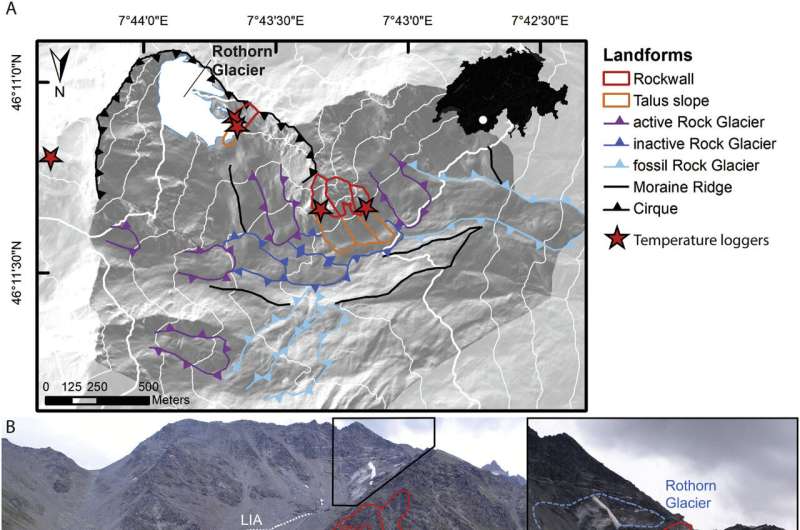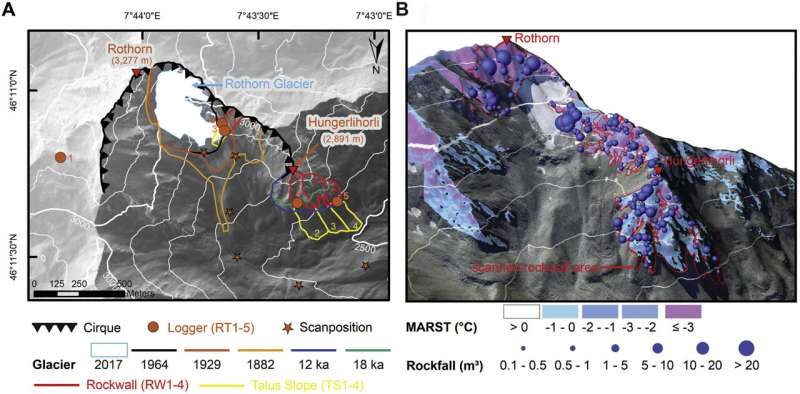January 20, 2024 feature
This article has been reviewed according to Science X's editorial process and policies. Editors have highlighted the following attributes while ensuring the content's credibility:
fact-checked
peer-reviewed publication
trusted source
proofread
Research suggests European Alps eroding slower than >10,000 years ago

Deglaciation during the Holocene (last ~17,000 years) has had significant impacts on the surrounding mountainous environments as glaciers retreated and left distinct landforms in their wake, such as debris ridges (moraines) deposited at the snout during retreat.
Further adding to this is the rate of erosion of the 'newly' exposed mountain slopes, which cause rockfall events, and is the focus of new research published in Earth and Planetary Science Letters which suggests erosion rates may be declining in more recent decades/centuries compared to earlier in the Holocene.
Dr. Daniel Draebing, of Utrecht University, Netherlands, and colleagues have studied the slopes of mountain bedrock (termed rockwalls) of the European Alps to test the role of climate warming in this change of erosion rates. The theory pertains to reduced glacial load since the last peak glacial period of the Younger Dryas (~12,900–11,700 years ago), causing a reduction in glacial debuttressing and therefore a decline in exposure of steep valley sides to erosion.
Combining real-world field data with modeling, the research team calculated 1.2–1.4 mm/year erosion rates for a periglacial alpine valley in southern Switzerland at ~9,000–10,000 years ago, based on debris at the base of the rockwall (talus slopes), and compared them to modern measurements of 0.02–0.08 mm/year erosion rates between 2016 and 2019.
Specifically, the scientists reconstructed the glacial retreat history of the Hungerli Valley, focusing on the temperature of the rockwalls and how this may have affected the occurrence of permafrost (rock/soil material that remains below 0°C throughout the year) and frost cracking (splitting of bedrock caused by freezing water).
The latter forms due to a process known as ice segregation, Dr. Draebing explains, adding, "Water freezes to ice and the ice draws additional water to the ice body, causing it to increase in size and produce stress that breaks down the rock."
Modeling frost cracking through time is based upon the percentage change in the porosity of the metamorphosed paragneiss and schist slate bedrock through fractures, fed by laboratory data testing the strength of samples taken from the study site.
Both permafrost and frost cracking weaken the rockwalls, leading to rockfall events, which may be further exacerbated by seismic activity occurring from changes in land stresses with the 'weight' of a glacier (glacial loading) being removed during melting.
Laser scanning surveys helped the research team to record changes in rockfall activity in the Hungerli Valley over the modern study period, identifying 263 events, with a maximum volume of 159.4 m3 for a single event. Such events were a hazard to the scientists during their field research, with Dr. Draebing saying, "Working in high-alpine environments is very demanding for a team physically and psychologically, and active rockfall is dangerous so these hazards had to be evaluated every day."

Dr. Draebing and colleagues found that higher average rates of erosion occurred throughout the middle to late Holocene on slopes that had been free of glacial ice since ~10,000 years ago, compared to the modern day, and attribute this to elevated intensity of permafrost and frost cracking.
This effect was intensified further with elevation, as mountain rockwalls above 2700 m experienced greater erosion than lower-elevation locations during the Younger Dryas, with a peak in frost cracking in the models. However, this pattern was found to break down over time, with a rapid decline in erosion rate. For example, over the past five decades, the highest recorded erosion rate at the site of 50.7 mm/year was two orders of magnitude higher than earlier in the Holocene, but declined to just 0.58 mm/year by 2019.
An initial high but subsequent rapid decay in erosion rate is postulated to be caused by a combination of increased frost cracking, thawing of permafrost and the adjustment of the landscape to the unloading of glacial ice.
Dr. Draebing suggests it is not possible to discern which of these three factors is most dominant in erosion. "All of these processes are affected by low temperature and precipitation (especially glaciers) so it is not surprising that they occur at the same elevation range as mountain temperature is a function of elevation."
"We moved down in elevation and did a comparable study on rockwall areas that are permafrost-free and not affected by recent glaciation to identify the role of frost cracking in erosion and to work on a system where we can exclude permafrost and glacier retreat, both of which made analysis more challenging."
Seasonal snow cover also plays a part, with thicker snow layers insulating the rockwall and delaying freeze-thaw processes. Overall, the research team concludes that frequent small-scale rockfalls occur in preference to larger-scale single devastating events as a result of glacial retreat.
Concerning whether erosion rates will continue declining until a future glaciation, Dr. Draebing says, "Erosion depends upon topographic stresses (such as slope steepness) and climate-induced stresses (like frost cracking, permafrost thaw and glacier retreat). Climate-induced stresses will decrease due to climate warming, however, topographic stresses will persist. Erosion rate will reach an equilibrium probably similar to current erosion rates of 0.02 and 0.08 mm/year."
This research is important in understanding the role deglaciation in a warmer world impacts processes affecting rock erosion, and therefore rockfall events, as climate change continues. In addition to permafrost and frost cracking, extreme weather events may also enhance erosion, as well as large-magnitude earthquakes.
The impact such situations may have on the local landscape and its inhabitants is vital to support the infrastructure mountain-dwelling communities and alpine tourism resorts rely upon, as well as wildlife struggling to adapt to the changing environment.
Dr. Draebing concludes, "Due to climate change, glaciers and permafrost will disappear and frost cracking will decrease, which in the long term will result in decreasing erosion rates. However, in the short term, glacier retreat and permafrost thaw will increase erosion rates and rockfall hazard, something mountain communities will need to adapt themselves to in the near future."
More information: Daniel Draebing et al, Holocene warming of alpine rockwalls decreased rockwall erosion rates, Earth and Planetary Science Letters (2023). DOI: 10.1016/j.epsl.2023.118496
Journal information: Earth and Planetary Science Letters
© 2024 Science X Network





















